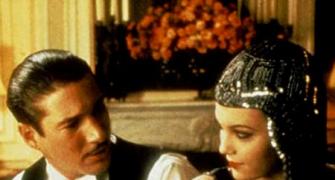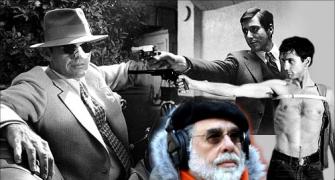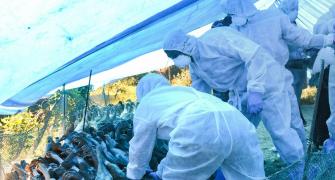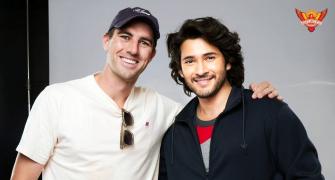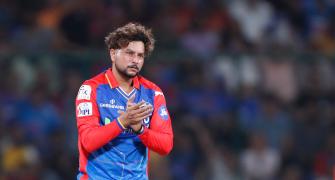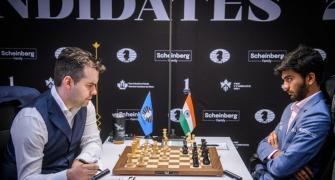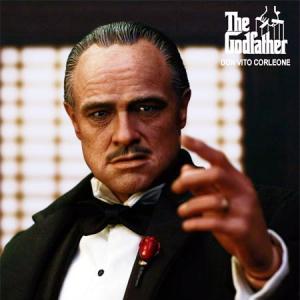Despite the Oscars, the box office glory, and the universal acclaim, Francis Ford Coppola, I am sure, remembers The Godfather with as much frustration as pride.
Like Michael Corleone, he got into it with the best of intentions, and got out of it on top, but lost in the heights.
Sreehari Nair revisits the masterpiece as it turns 50 this month.

While it continues to be one of the most loved and imitated movies of all time, Francis Ford Coppola's The Godfather is also one of the most misunderstood movies of all time.
And why should this surprise anyone?
The Godfather, after all, is so virtuosic that you might find yourself frequently leaping into a state of rhapsody, and overlooking thereby its tragic core.
People are known to quote the movie's dialogues out of context.
They often discover the politics of bravado, and life lessons, in what is essentially a somber tale.
They commercialise it all out of proportion.
A flashy entrepreneur may use Vito Corleone's 'I'll make him an offer he cannot refuse' as a throwaway line, a jocose quip to ease the tension before serious business matters get discussed.

Michael Corleone's elaborately planned murders and retributions are, today, considered ideal case studies for an MBA class presentation about Decision Making and Strategic Management.
Second only to Beethoven's Fur Elise perhaps, Nino Rota's melancholic waltz for The Godfather ranks among the most recognisable compositions ever, heard as ringtones and heard in elevators, underscoring everything from musical reverse gears to improperly cradled intercom handsets.
When Coppola was writing the film through most of 1970, prepping, shooting and editing it through a good part of 1971, and readying it for release in 1972, he had little idea that he was about to unleash a significant piece of pop culture.
Even more ironically, he had no inkling that future generations would treat The Godfather as a rapturous film, as a film to get high on. And yet, that is exactly what happened.
Cinephiles who compare The Godfather with just about any wham-bam action picture, which has elements of 'family' and 'revenge' fused into some synthetic mood of exultation, may do well to realise that Michael Corleone's arc concerns an honourable man's decline into total corruption and moral depravity.
Those cinephiles who see Don Vito Corleone as the ultimate symbol of manly strength, virility and unimpeachable wisdom, may do well to remind themselves that Vito is shown to be at the peak of his powers at the start of the movie, and as the story progresses, we see his feathers slowly coming out and him taking leave of us finally as a dejected man, an uneventful death in an insipid tomato garden.
In The Godfather movies, unlike, say, in Amal Neerad's terribly styled pictures, scenes of violence are not there to give the audience a kick, and the last man standing after a savage contest is not a winner but a consummate loner who doesn't have even his solitude to fall back on.
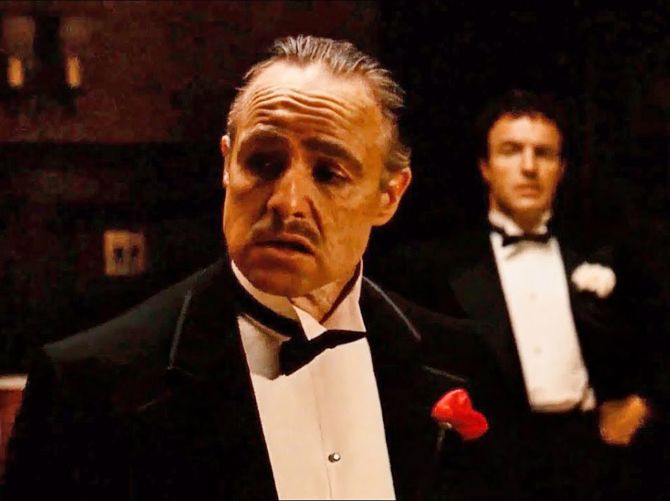
So, as Coppola's opus turns 50, here's a point well worth considering: While everything that happens in the movie can broadly be termed exhilarating -- the shootings, the sinister plottings, the double crossings -- the gaze of creation that marks out The Godfather is tinged with sadness.
And when people don't give this sad gaze its due, they commit a misreading as grave as what happened in the case of Citizen Kane, which was meant to be a comedy, but which the French and the Francophiles read as a cautionary tale about untrammeled ambition. Pas Du Tout!
But no tragic masterpiece ever runs and endures on the motor of pessimism alone.
It needs vitality, and the vitality in The Godfather was supplied by Coppola's belief that he was making a personal film, an evocation of a period he knew too well (America after World War II), an account of an Italian-American family just like his own.
The unique vision of the film flows from the fact that Coppola gave to the religious customs, the music and the celebrations the same emotional weight that he gave to all the shady dealings, the garrotings, and the bloodlettings.
And this openhanded approach is what, in fine, led to the film-maker being harangued by Robert Evans and his henchmen at Paramount Pictures, who wanted something closer to Mario Puzo's source novel which, while an efficient page-turner, was written to make some fast buck by appealing to a reader's basest sentiments.

The story of the studio being dead against casting Marlon Brando in the role of Vito Corleone is legendary, but the opposition to Brando was, it seems, so focused that the president at Paramount had told Coppola that an unknown might be better for the role.
So Brando arrived on the sets as de-feathered as his character eventually becomes, and a few days into the shooting, during the scene in the Olive Oil Company where he turns down Sollozzo's offer, it was deduced that the actor was playing the character too feebly, and that for a man that powerful he was mumbling too much.
This was thought to be Coppola's fault and he was to be replaced on a Friday with the film's original editor Aram Avakian (co-director of that magical concert film, Jazz on a Summer's Day), who had formed a parallel government of sorts within the team. But before the replacement could happen, Coppola made a preemptory strike by firing the renegade gang led by Avakian on the Wednesday of that week.
The Godfather dealt with the dance of power, and the crew was getting a taste of the theme as they were making the movie.

Coppola had cast Al Pacino after watching him in an Israel Horowitz Play, The Indian Wants the Bronx, and while the actor did not fit the description of Michael in the book, he somehow blended with the personal vision that Coppola had for the film.
Paramount gave Pacino equal hell, and what saved him in the end was his performance in the restaurant scene where Michael kills Sollozzo and the corrupt cop, after a lot of teeth clenching, a lot of thrashing out in Italian (not supported by subtitles, mind you), a long bathroom break, and after the sound of a speeding train has almost crashed into Michael's thoughts.
'Hurrying it is the only way to ruin it. Otherwise, it cannot be ruined,' Coppola had written about the restaurant killing scene in a notebook he had created to prepare the script of The Godfather.
An aspiring screenwriter can experience a lifetime of learning by simply going through the potential pitfalls that Coppola had jotted down for each scene this way. For instance, for the section in Sicily involving Apollonia, the following anxiety had been expressed, 'If Apollonia does not make your heart stop, just to look at her...' And sure, Simonetta Stefanelli does make your heart stop the moment she appears on screen.
She comes on like a flower of the mountains, yes!
Coppola had a sensationalist and action-filled source at hand, and his strategy was to slow things down, build the tension, and feed misdirection wherever possible.
While shooting the restaurant scene, he had hidden the gun in a place that wouldn't be easy to reach for, so that Pacino (as Michael) would have to stretch and grope to pocket the weapon.
You can see how that five second delay adds to the realism of the scene.

In the scene of the Hollywood producer waking up covered in blood, Coppola digresses from the book and plays around with the denouement, so that we are led to believe that it's the producer who has been shot, before we are hit finally with a horse's loyal head and his master's high-pitched scream.
Many of these sequences were prepared in advance, and the soul of the film was discovered in these preparations.
But 32-year-old Coppola was also an ardent student of the French New Wave, was married to an Irish lady with bohemian roots, and had for friends a set of avant-garde artists.
This meant that he was very open to the idea of 'happy accidents' throughout the making of The Godfather.
The cat that you see being fondled in the opening scene had just casually walked onto the set (as cats often do), and it was placed on the lap of Marlon Brando, who rubbed its ears and the back of its neck while listening to Bonasera's heart-wrenching story.
Lenny Montana, who played Luca Brasi, kept bungling his lines when talking to the Don, so Coppola had the wonderful idea of shooting a scene that showed him rehearsing his speech in the hall outside. The speech rehearsal bit was shot later.
The exterior scenes of Robert Duvall's Tom Hagen going off to meet Hollywood producer Jack Woltz was shot in California by a second unit, and the actor featured there in numerous wide shots is not Duvall but a body double.
On the other hand, the medium and close-up shots of the Hollywood section were photographed with the real Duvall, albeit on a set in New York.
Richard Castellino, who played Clemenza, had improvised the famous line, 'Leave the gun, take the Cannoli,' and the lead-up scene to this bit was shot after the line had been devised, with Coppola prompting the actress who played Clemenza's wife to call out to her husband and say: 'And don't forget the Cannoli.'

Castellino also contributed to most of his dialogues in the scene of sausage cooking, and when the line, 'You burn the sausage,' was sent to Mario Puzo for his expert comments, he had replied with the following: 'Gangsters don't burn, they fry.'
Coppola's relationship with Puzo was very cordial (though they had a major argument on the second part), but with Gordon Willis, the cinematographer, it was a case of breaking through a purist's set methods.
The lunchtime scene during the opening wedding, featuring Michael and Kay (Diane Keaton), was shot on a dark night with the lights all blaring (the budget didn't allow for an extra day of shoot), and Willis abhorred the idea.

Willis also couldn't empathise with Coppola's request, for slow zoom-ins, in several sequences.
In the scene of the Don being fired by assassins while buying oranges, Coppola wanted a shot from the window overhead so that the falling oranges could be captured, and this upset Willis who wanted to know whose point-of-view the shot was supposed to represent.
Coppola's answer was enough to stun the great cinematographer. 'It's my point-of-view, it's Orson Welles' point-of-view,' he said.
There was a similar stand-off during the scene of Sollozzo's killing, where Coppola wanted the camera to be held a little high so as to capture the period detail of the floor having been stripped of linoleum. This time, Willis grudgingly went along without further questions.

While the technical crew was in equal parts for and against Coppola, the director had the absolute support of his actors.
The 'breakthrough night,' as Coppola calls it, was the one when he had Brando, Pacino, Duvall, James Caan (who played the vigorous and quick-tempered eldest son Sonny) and John Cazale (who played the weak one, Fredo) all seated around a table in the backroom of a restaurant, with Brando as the head, and with Coppola's younger sister Talia Shire (whose Connie is the trilogy's true gathering force), serving them Italian food.
By the time the improvisation that happened over that meal came to a close, the cast had become, over slurping and thigh-slapping, a real family.
It was, in a sense, because his actors rallied around him and his vision that Coppola couldn't be sacked by Robert Evans and the meddling men at Paramount, who were unhappy with the rushes, wanted the shoot to be speeded up, and, believe it or not, wanted Nino Rota's score to be taken out completely.
But they were proved wrong within a week of the film's release, by the glowing numbers and the reviews, and soon, the moneymen were at Coppola's feet begging him to make a sequel.
'Francis, you've got the formula for Coca-Cola,' went one of the big honchos in a Viennese accent, and after Coppola couldn't convince them that Martin Scorsese could maybe direct the sequel, three demands were laid down.
'Demand Number One. I want X million dollars,' declared Coppola.
'I want Robert Evans to have nothing to do with the sequel.'
'I want the sequel to be called The Godfather Part II.'
The third demand was debated over, they wrestled on the floor once more, and Coppola won out, though in hindsight he must be chiding himself for having set in motion a trend of monstrosities like Iron Man 3 and Rocky V.

The brilliance of The Godfather Part II is that it completes the story begun in Part I.
We get a delicately served yet operatic view of the Italian immigrant's experience, of American prosperity after the Second World War reaching mammoth proportions, even of America's questionable foreign policies, and of the ultimate corruption of every stakeholder involved in scripting the money fever.
In the flashback scenes, Robert De Niro, as a young Vito Corleone, does not just impersonate Brando; he gives a performance that becomes a prologue to the Vito we had met in Part I.
In De Niro's act, we can catch the formation of the Don's physicality and the shaping of his instincts.
In The Godfather Part II, the events set in the present -- notably, Michael's hassles with the law, his visit to Cuba, the Hyman Roth Conundrum -- were Coppola's inventions.

Puzo did not have a problem with his re-interpreter for the most part, but he simply couldn't swallow the idea of Michael Corleone bumping off his weak brother, Fredo.
Puzo had written a story soaked in blood, but he still cared for the audience's sympathy, and he thought the audience would never forgive Michael should he oversee something so dastardly.
Mario Puzo, one must remember, was going for mass appreciation (and to his credit, he achieved it), but Coppola wanted something more. He wanted the mass appreciation lavished upon Shakespeare and Strindberg.
The director's sensibility prevailed, and Michael Corleone, the ex-marine, was left at the end of Part II ruminating about what he once was and what he had become.

Coppola did make Michael regret Fredo's murder in The Godfather Part III. And I want to see if I can link this overtly apologetic tone to something that happened to the film-maker post the first two Godfather films and The Conversation.
Footage from the shooting of Apocalypse Now (immortalised in Eleanor Coppola's documentary, Hearts of Darkness) show a shaggy, thinning Coppola growing all manic-depressive, like Werner Herzog, and trying to reach down into the deep-set Christian belief that if you are successful and have made money, you have, in essence, sinned against God.
He seems to have, from that point on, become intent on marrying that Christian belief with the belief that a true artist must expose his wound to the world (This same fallacy has afflicted such geniuses as David Foster Wallace and Charlie Kaufman, impairing their ability to tell an interesting story).
And so, with 'I am an artist suffering in his success' tattooed on his forehead, Coppola made the third part of The Godfather.
This time, his fights were not with a studio but with his own stifling theories. And it is for this reason that the tone of the film feels willed into existence with great effort.
The tragedy in Part III seems manufactured, the portrayal of all-round corruption in it feels heavy-handed, and it doesn't spew out onto the screen with the smoothness of the first two films.
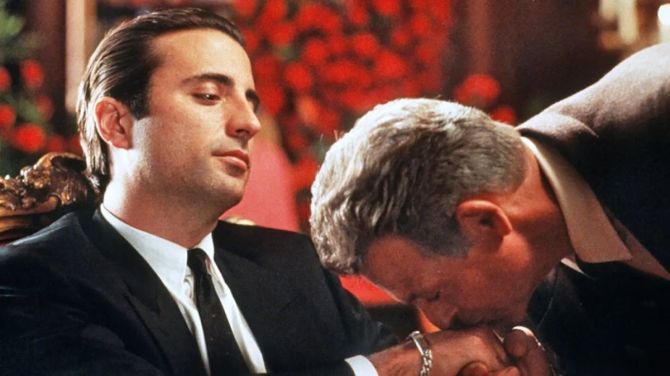
But why should we trifle with an aberration like The Godfather Part III when we can saturate ourselves in its two predecessors, among the greatest works of art produced since the dawn of Christendom?
It has been 50 years since it all started, The Godfather mania, and celebrations are very much in order.
But I wonder, what would be Francis Ford Coppola's take on such revelries?
The Godfather was Coppola's attempt to look at power and the powerful with moist eyes.
It was put together in a state of boundless creative energy, undermined constantly by enormous restrictions on creative freedom.
He fell out with old friends, and made more than a few permanent enemies.
Hired by the studio so that he could be pushed around, he discovered within himself a capacity for suppressing strife with strife, and the experience left him with so many scars and demons that he today regards winemaking as the most pleasurable job he has had.
Despite the Oscars, the box office glory, and the universal acclaim, Coppola, I am sure, remembers The Godfather with as much frustration as pride.
Like Michael Corleone, he got into it with the best of intentions, and got out of it on top but lost in the heights.


